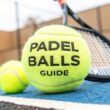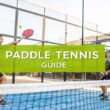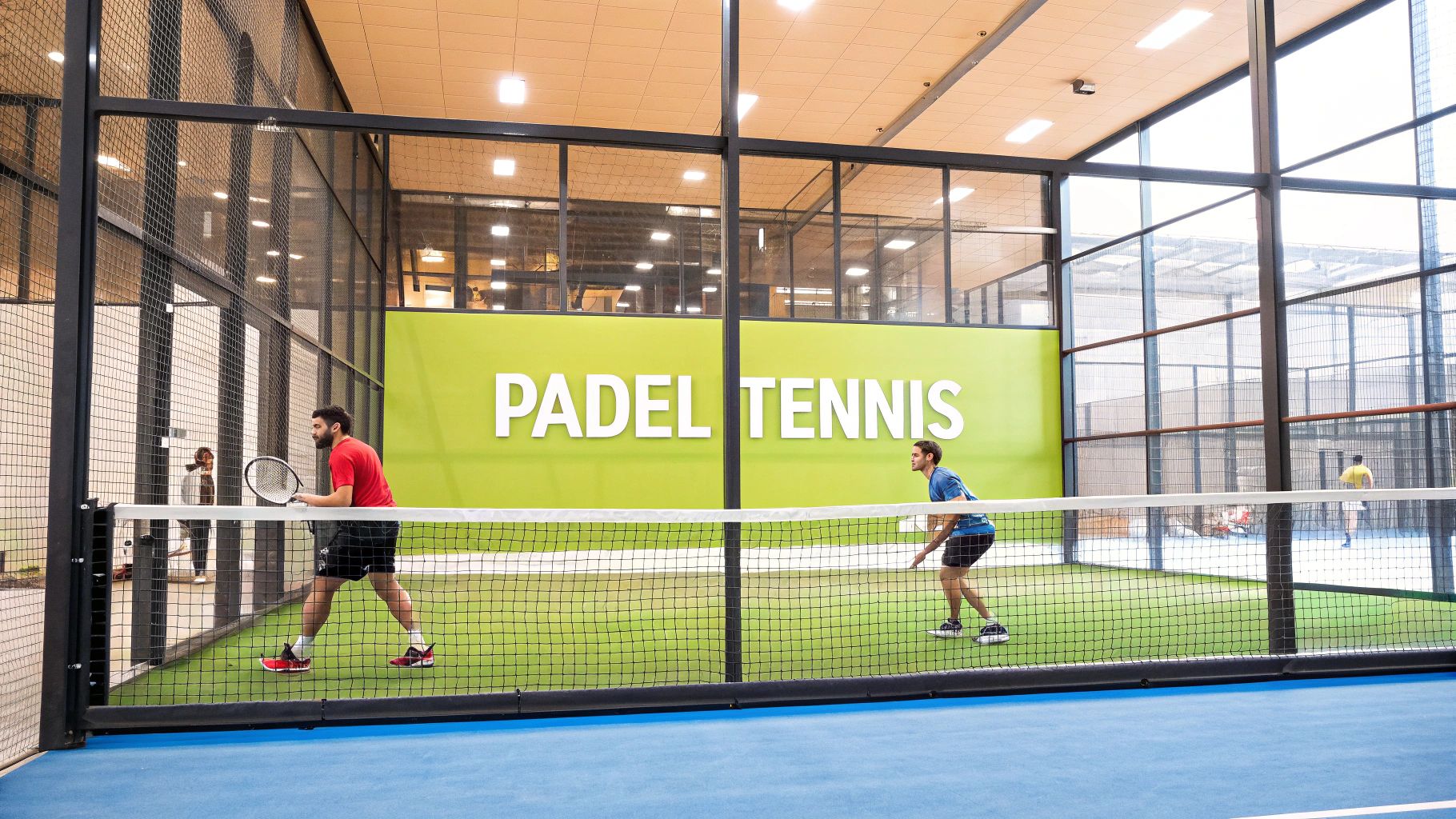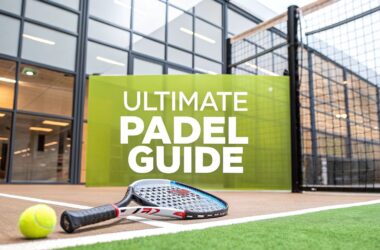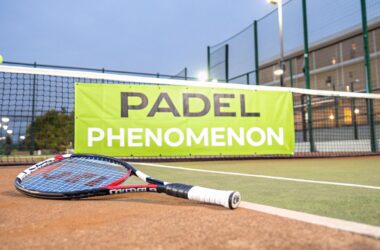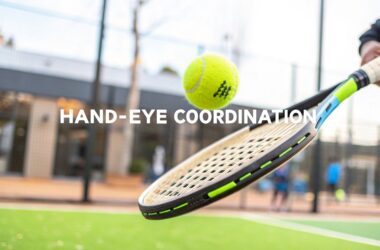So, you’ve heard the buzz about padel tennis and are wondering what all the fuss is about. You're in the right place.
Padel is a super dynamic racquet sport that feels like a brilliant mashup of tennis and squash. It's played exclusively in doubles on a small, enclosed court, using a solid, stringless racquet. The best part? You get to strategically use the glass walls to keep the ball in play, leading to some incredibly fun and long rallies.
Unpacking the World of Padel Tennis
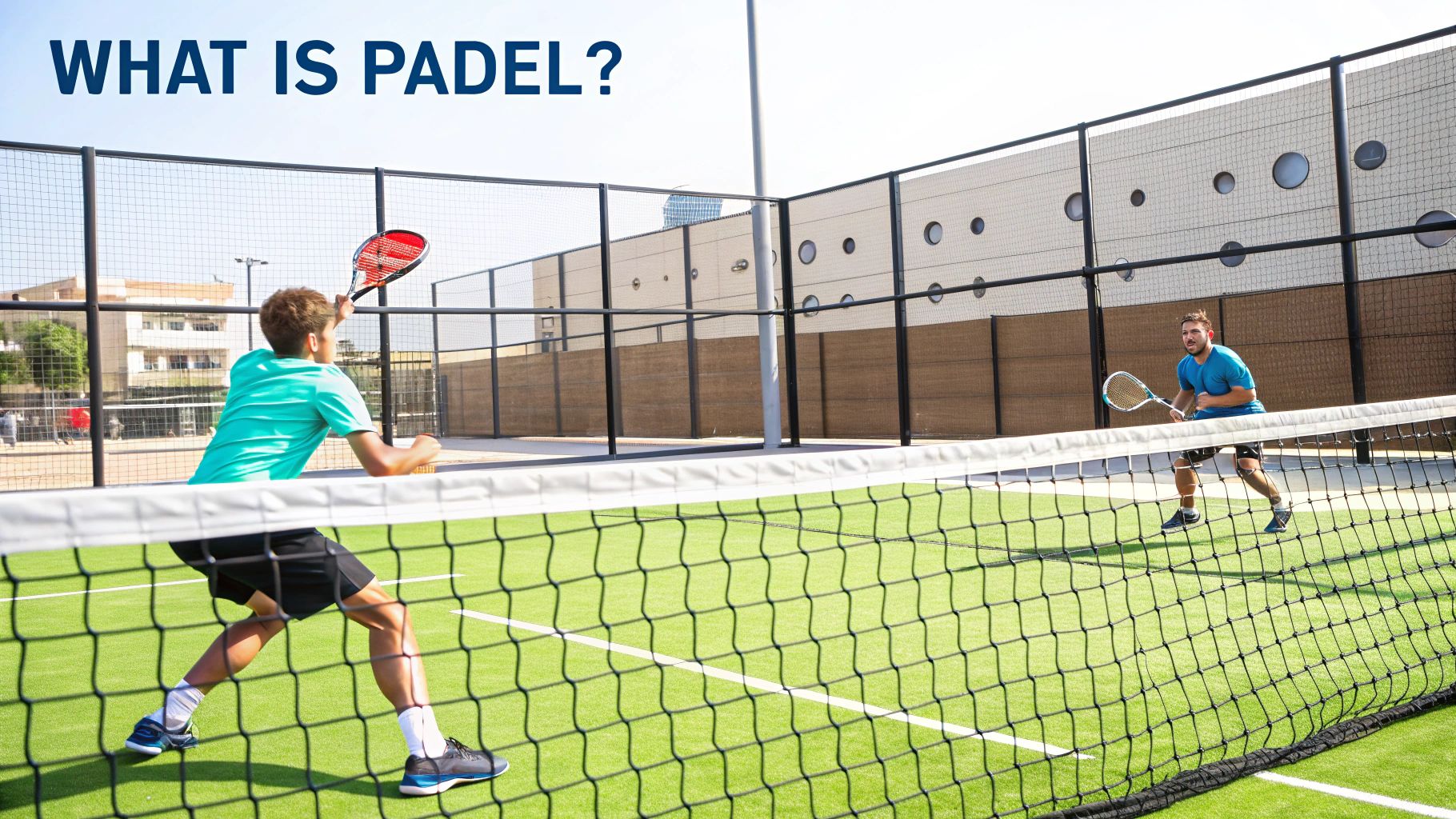
Honestly, the easiest way to think of padel is like tennis in a box. This little analogy really captures the essence of the game. The action happens on a court that's about one-third the size of a standard tennis court, surrounded by a combination of glass and mesh walls. This enclosed space not only keeps the game moving at a brisk pace but turns the walls into a strategic part of the rally.
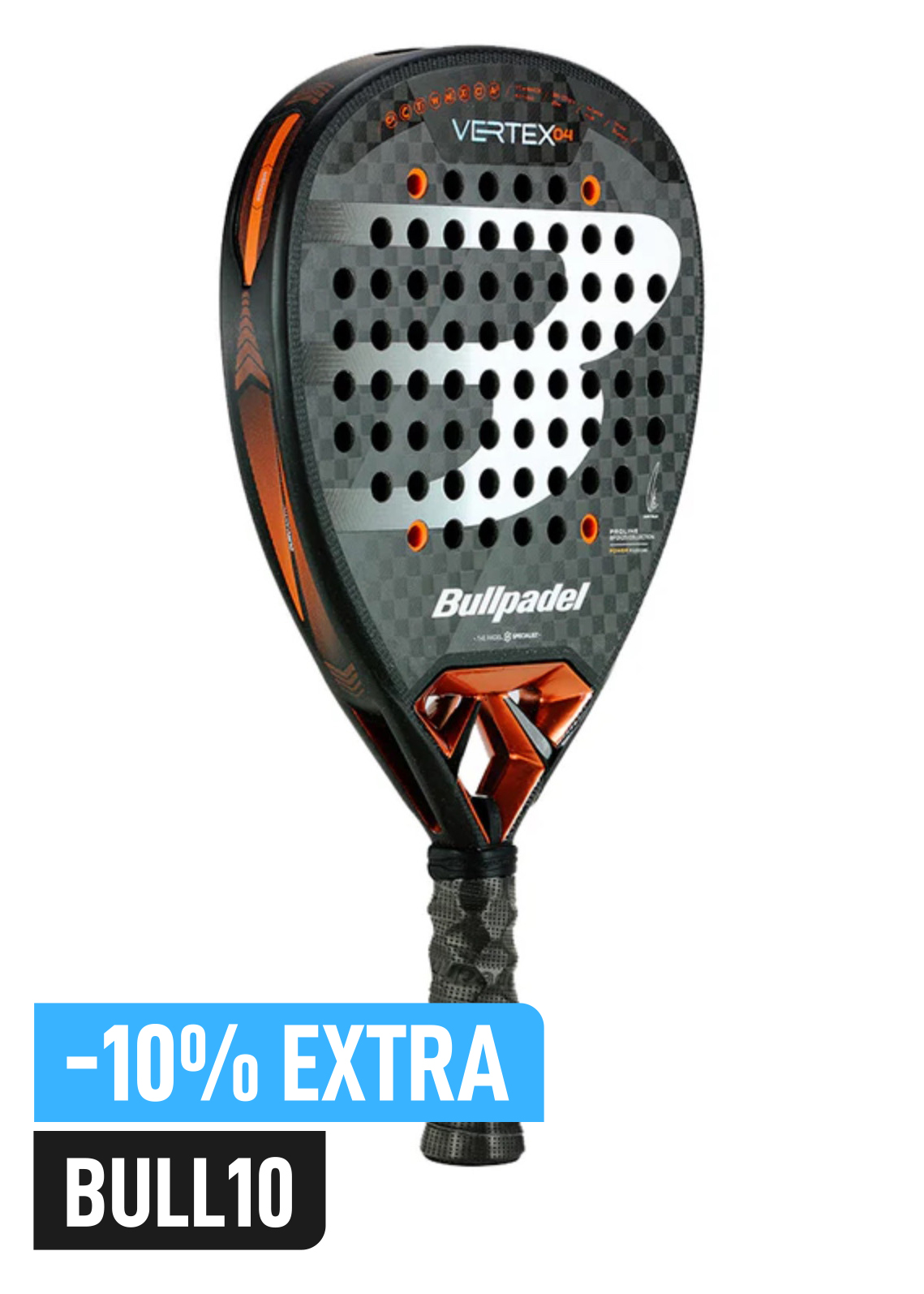
Buy the best padel gear to level up your next game!
CHECK OUT this deal from Padel Market!Get ready to take your game to the next level with the latest padel gear from Padel Market! Fast EU and Worldwide Shipping
And unlike the powerful, hard-to-return serves you see in tennis, padel kicks things off with a simple underhand serve. This small detail makes a huge difference—it means even absolute beginners can pick up a racquet and start a proper rally almost immediately. It's this easy entry point that's a massive reason for its soaring popularity.
A Rapidly Growing Global Phenomenon
It's no exaggeration to say this sport is one of the fastest-growing in the world. The global player base is now hovering around 30 million individuals, which is a massive jump from just 12 million a decade ago. That's a 2.5 times growth, showing just how many people are falling in love with the game. Padel has now broken into at least 130 countries, pushing its reach far beyond its Spanish-speaking origins. If you're interested in the numbers, pala-hack.com offers some great insights into padel's global statistics.
The magic of padel is in its mix of simple rules, incredibly social gameplay, and surprising strategic depth. It’s less about brute force and much more about teamwork, clever shot placement, and using the court's unique angles to outsmart your opponents.
Padel’s core appeal lies in its social nature and accessibility. It removes the steep learning curve of tennis while keeping the strategic excitement of a racquet sport, making it an ideal activity for friends and families.
To give you a clearer picture, here’s a quick breakdown of what makes padel, well, padel.
Padel at a Glance
This table gives you a quick summary of the fundamental components of padel tennis.
| Component | Description |
|---|---|
| Players | Always played in doubles (two vs. two). |
| Court | A smaller enclosed court (10×20 meters) with glass and mesh walls. |
| Serve | Must be served underhand, making it easy to learn. |
| Racquet | A solid, stringless "pala" with holes for aerodynamics. |
| Scoring | Identical to tennis (15, 30, 40, game). |
As you can see, the game borrows some familiar elements but puts its own unique spin on things, creating a sport that's both easy to start and hard to put down.
The Padel Court and Essential Gear Explained
To really get what padel is all about, you have to understand its unique playing environment and the specialized gear that makes it tick. A padel court isn't just a smaller version of a tennis court; it's a completely different kind of arena, built for strategy and quick reactions.
The court itself is a compact 20 meters long by 10 meters wide. This smaller footprint is what keeps the action tight and makes teamwork so crucial.
What really sets it apart, though, are the walls. The entire court is enclosed by a mix of reinforced glass and metallic mesh. These walls aren't just there to keep the ball in play—they are in play. Think of it like a game of squash or racquetball; you can bounce the ball off the glass walls to pull off incredible defensive returns and create tricky angles your opponents won't see coming. It's a huge part of what makes the rallies so long and exciting.
The sheer speed at which these courts are popping up is a testament to the sport's explosive growth. We're seeing massive global investment in padel infrastructure. One report highlighted that over 3,282 new padel clubs opened their doors worldwide in just one year. That works out to a new club opening its doors roughly every 2.5 hours. If you're curious about this boom, you can learn more about how padel is crossing into the mainstream with Playtomic's global report.
The Essential Tools of the Game
It’s not just the court that's different—the equipment is totally unique to padel, too. You won't find any stringed racquets here. Instead, players use a "pala," which is a solid, stringless paddle.
These palas are typically made from a foam core wrapped in composite materials like carbon fiber or fiberglass. The face is covered in small holes, which do two things: they cut down on air resistance so you can swing faster, and they soften the ball's impact, giving you a lot more control. This design makes it way easier for beginners to get a feel for the ball compared to the steep learning curve of a tennis racquet. If you're just starting out, our guide to padel tennis equipment can help you choose the right gear.
Finally, let's talk about the ball. It looks almost identical to a regular tennis ball, but there's a key difference: a padel ball has slightly lower internal pressure.
This lower pressure means the ball bounces less and moves a bit slower through the air. It’s a small change, but it makes a huge difference, giving players more time to get into position and set up their shots. This is what helps create those long, strategic rallies that make the game so addictive and accessible for everyone.
This blend of a one-of-a-kind court and specially designed gear is what gives padel its signature feel—a perfect mix of fast-paced fun, strategic depth, and accessibility for players of all levels.

Buy the best padel gear to level up your next game!
CHECK OUT this deal from Padel Market!Get ready to take your game to the next level with the latest padel gear from Padel Market! Fast EU and Worldwide Shipping
Understanding the Basic Rules and Scoring
Alright, you've got the court layout and the gear sorted. Now for the fun part: playing the game. Padel might look like a whirlwind of activity, but the rules are surprisingly simple. It’s one of the easiest racquet sports to just pick up and play, and if you have any experience with tennis, you're already most of the way there.
Every single point kicks off with an underhand serve. The rules are simple: you let the ball bounce once behind the service line, then hit it at or below your waist. Your serve has to fly diagonally over the net and land in the opposite service box. This gentle, user-friendly serve is a game-changer for beginners. It completely removes the tough learning curve of a big tennis serve and lets you jump straight into exciting rallies.
The Flow of a Padel Rally
Once the serve is in and returned, the rally is on, and this is where the magic of padel truly comes alive. The main rule to remember is that the ball can only bounce on the ground once on your side before you have to hit it back. You can either play it after the bounce (a groundstroke) or hit it out of the air before it bounces (a volley).
But here’s where things get really interesting. After the ball bounces on your side of the court, you can let it rebound off the glass walls before you make your shot. This completely opens up the game, creating all sorts of strategic angles and allowing for much longer, more dynamic rallies than you'd see in tennis.
The core principle is simple: ground first, then wall. A ball that smacks a wall directly without bouncing on the court first is out of bounds.
Imagine your opponent hits a hard shot to the back of your court. Instead of scrambling, you can calmly step back, let the ball bounce, watch it come off the back glass, and then play your shot as it moves back towards the net. This defensive play is fundamental to padel strategy. For a deeper look into all the scenarios, check out the comprehensive rules of padel in our detailed guide.
How Scoring Works in Padel
Ever watched a tennis match? Good, because you already know how to keep score in padel. The system is identical, making it instantly familiar for anyone new to the sport.
Here’s a quick refresher on how you tally up the points, games, and sets:
- Points: The points follow the classic sequence: 15, 30, 40, and then game.
- Deuce: If both teams are tied at 40-40, it's called "deuce." From here, a team has to win two points in a row to win the game.
- Games and Sets: The first team to win six games takes the set, but you have to win by at least two games (like 6-4). If the score gets to 6-6, a tie-break is usually played to decide it.
- Matches: Most padel matches are the best of three sets. The first duo to win two sets wins the whole match.
This familiar scoring, combined with the easy-to-learn serve and the exciting wall play, is exactly why padel is so addictive. It lowers the barrier for new players, letting you focus less on memorizing rules and more on having a great time.
Padel vs. Tennis vs. Squash: A Clear Comparison
To really get what makes padel so special, it helps to put it side-by-side with its more famous cousins, tennis and squash. They all involve hitting a ball with some kind of racquet, but the vibe, strategy, and overall feel of each game are world's apart. This comparison will show you exactly where padel carves out its own unique space.
At first glance, many people mistake padel for a simple hybrid. It borrows the net and scoring from tennis while taking the wall-play concept from squash. But what it creates is something entirely new. For instance, padel's smaller court and mandatory underhand serve make it way more accessible and less punishing on the body than tennis, where raw power and athleticism often dominate.
This accessibility is a huge part of its charm. Padel shifts the focus away from booming serves and lightning-fast groundstrokes toward smart strategy, patience, and doubles teamwork.
The Core Gameplay Differences
In tennis, the court is big and open. The name of the game is hitting the ball where your opponent can't possibly reach it, and the walls are strictly out of bounds. Squash flips that script completely—there’s no net, and both players are crammed into the same space, smacking the ball against a front wall. Padel finds the perfect sweet spot right in the middle.
Padel’s genius is in how it blends these elements. It keeps the friendly, back-and-forth rally you get in a net sport like tennis but layers on the strategic depth of using wall bounces like in squash. The result? Longer, more exciting, and more engaging points.
This changes the entire dynamic of a rally. A shot that would be a clean winner down the line in tennis might just be another returnable ball in padel if your opponent is savvy enough to play it off the back glass. The game becomes less about brute force and more about crafting clever angles and thinking two steps ahead. For a deeper dive into this, you can check out this in-depth article comparing padel vs. tennis.
This image really highlights the key gear that gives padel its distinct character.
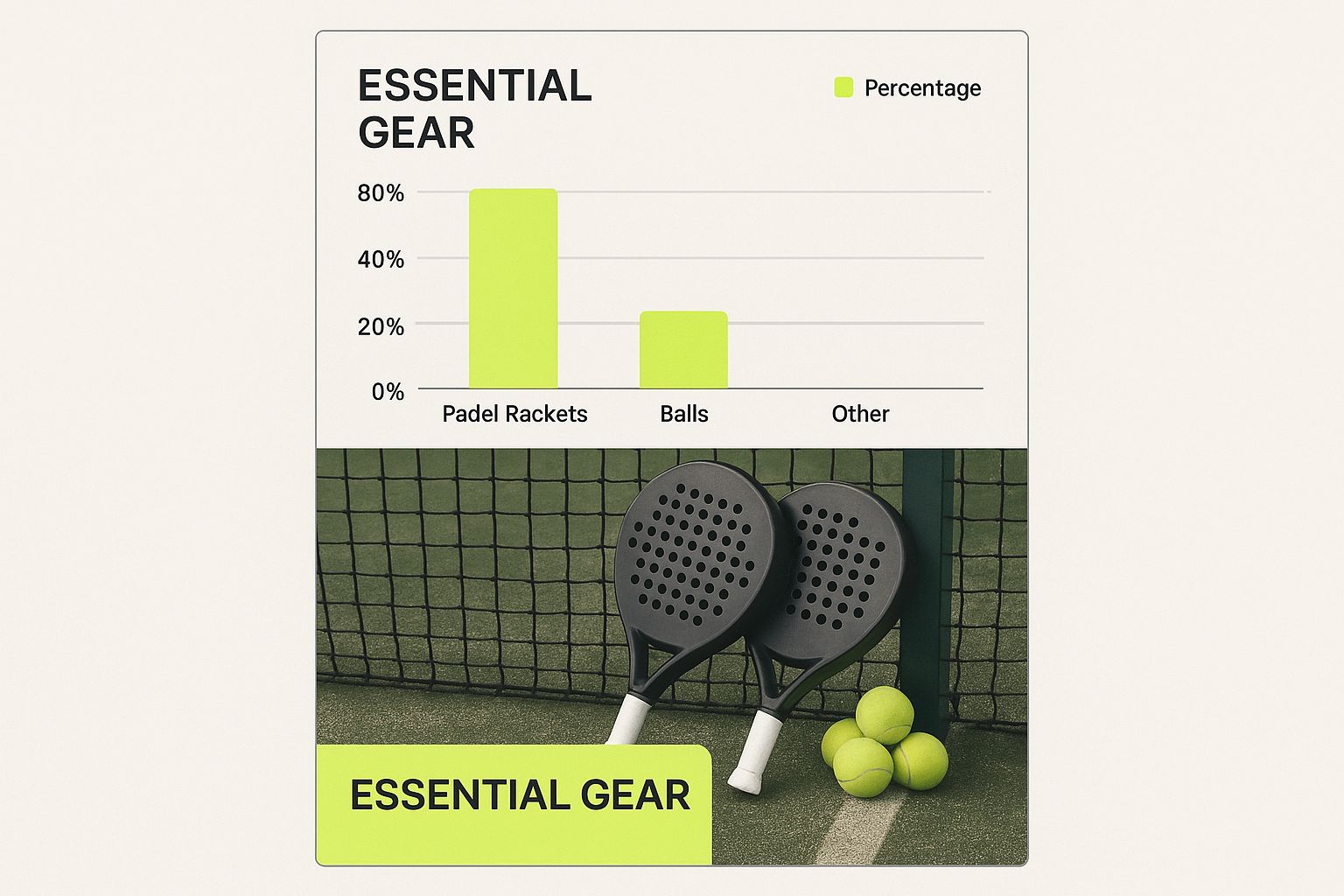
As you can see, the solid, stringless "pala" and the specific padel balls are central to the game's slower pace and heavy emphasis on control over power.
Padel vs. Tennis vs. Squash
Let's break it down feature by feature to make the differences crystal clear. This table lays out exactly how padel stands apart from tennis and squash in every key aspect of the game.
| Feature | Padel | Tennis | Squash |
|---|---|---|---|
| Court Size | Smaller (20m x 10m) | Large (23.77m x 10.97m) | Smallest (9.75m x 6.4m) |
| Players | Doubles Only | Singles or Doubles | Singles or Doubles |
| Walls | Used in play | Out of bounds | Used in play |
| Serve | Underhand | Overhand | Overhand |
| Racquet | Solid, stringless "pala" | Stringed Racquet | Stringed Racquet |
| Net | Yes | Yes | No |
From the court size to the type of serve, it's easy to see that while they share a family tree, padel is truly a sport of its own.
Why Padel Is Exploding in Popularity
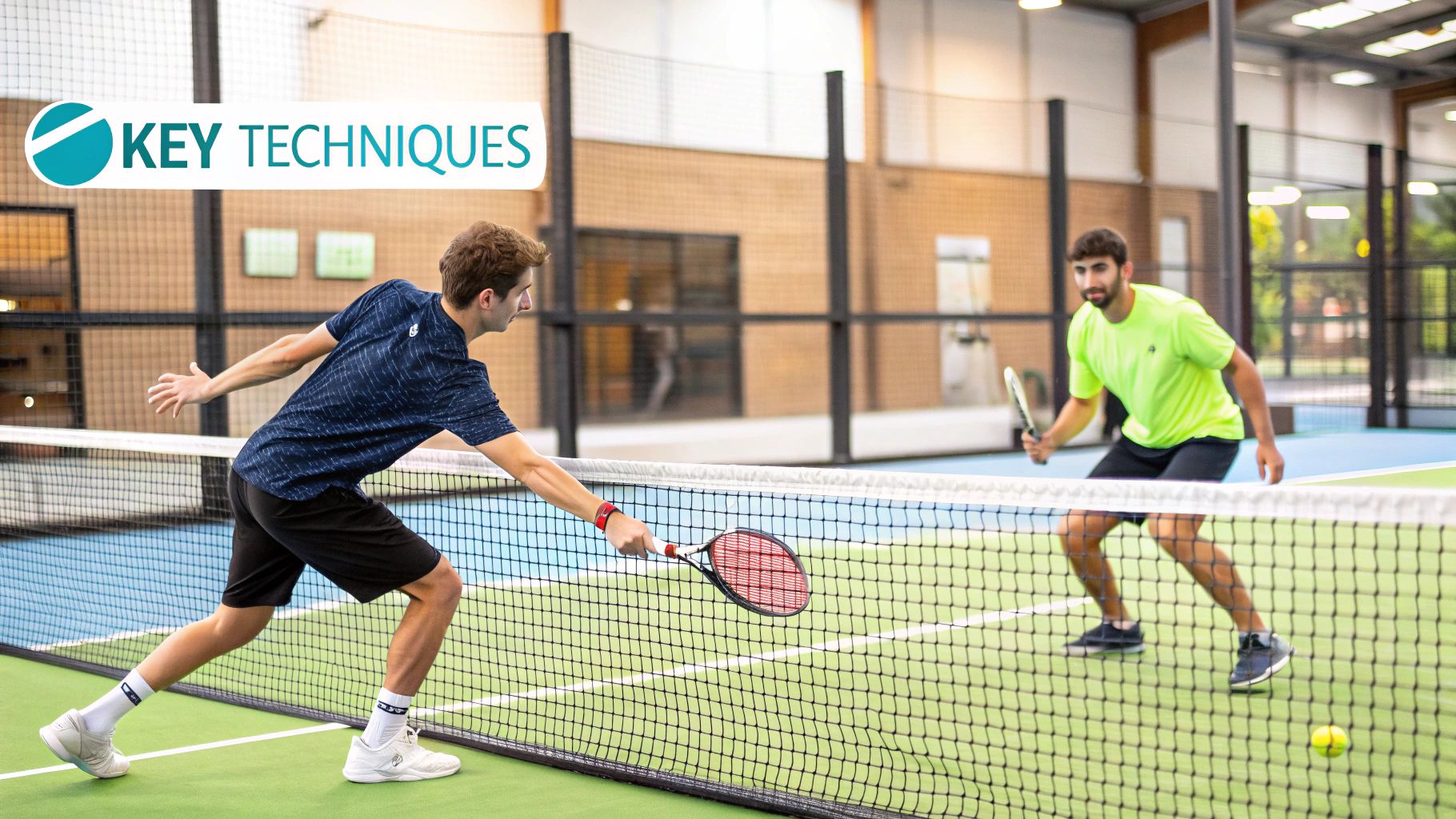
So, what’s the secret sauce behind padel’s global takeover? It isn't just one thing. It’s more like a perfect storm of accessibility, social connection, and pure, unadulterated fun that has turned it into a worldwide phenomenon. The sport's incredible growth is really fueled by something deeply human: it just brings people together.
Unlike some racquet sports that demand hours of practice to get the hang of complex techniques, padel welcomes newcomers with open arms. Its smaller court means you're not sprinting sideline to sideline, and the underhand serve completely removes the intimidation of facing a blistering, hard-to-return tennis serve.
This low barrier to entry is huge. It means a group of four absolute beginners can be having a fun, competitive rally within their first ten minutes on the court. But while that accessibility gets people in the door, the real magic is woven into its DNA as a doubles-only sport.
The Social Heart of the Game
Padel is, at its core, a team game. You're never out there alone. You're constantly communicating, strategizing, and working with your partner. This built-in teamwork transforms what could be a simple workout into a genuinely shared social experience. It’s the perfect excuse for friends, family, or even coworkers to connect.
Because the court is smaller, all four players are in close proximity, which creates a lively, conversational vibe you just don't get in tennis. Laughter and friendly banter between points are as much a part of the game as the shots themselves. This social dynamic is a huge reason why people don't just play padel—they become part of a community.
Padel thrives because it's as much a social gathering as it is a sport. The game's design naturally encourages communication and camaraderie, making every match an opportunity to connect.
And the numbers back it up. The global padel sports market was recently valued at USD 222.3 million and is projected to nearly double, hitting USD 426.2 million within the next decade. Europe is leading this charge, home to a whopping 64% of the world's clubs and facilities. You can discover more insights about the padel sports market on intelmarketresearch.com.
A Sport That Welcomes Everyone
One of padel's greatest strengths is just how inclusive it is. Because it relies more on strategy and quick thinking than on raw athletic power, it levels the playing field for people of all ages and fitness levels. It’s not uncommon to see a teenager playing with their grandparent or a seasoned athlete paired up with a casual player for a genuinely competitive game.
This unique mix of factors creates an experience that is both compelling and addictive:
- Easy to Learn: The underhand serve and smaller court mean new players can start having fun right away. No steep learning curve here.
- Highly Social: The doubles format and close quarters foster constant teamwork and conversation.
- All-Ages Appeal: It's less physically demanding than other sports, allowing different generations to play together and enjoy a great match.
Ultimately, padel has captured hearts worldwide because it delivers on a simple promise: an engaging, strategic, and incredibly fun social activity that just about anyone can enjoy.
Ready to give padel a shot? Getting started is a whole lot easier than you might think. The sport is exploding globally, so courts are popping up everywhere. Your first move is just finding one.
These days, court-booking apps and websites have made finding a court a total breeze. Just punch "padel courts near me" into a search engine, and you'll likely see a bunch of options. Most of these platforms let you check availability, book a time slot, and even connect with other players who need a game. All the usual hassle is gone.
Your First Time on the Court
Once you've got a court lined up, you'll need some basic gear and a little bit of guidance. Don't feel like you have to go out and buy the most expensive stuff right away—just focus on the essentials to get a feel for the game.
- Find a Beginner Racquet: Ask for a round-shaped "pala." This design gives you a much bigger sweet spot and is built for control, not power. It’s perfect for learning the ropes without sending the ball flying every other hit.
- Book an Intro Lesson: Seriously, one of the best things you can do is sign up for a beginner's clinic or a one-off lesson. A good coach can show you the proper grip, how to do the underhand serve correctly, and the basics of using the walls to your advantage.
An introductory lesson is a massive shortcut. Not only does it get you up to speed faster, but you'll also meet a bunch of other new players, which makes finding people to play with later on way easier.
Getting that initial guidance helps you build a solid foundation so you don't pick up bad habits. After that, the best way to get better is just to play. So grab three friends, book a court, and go see for yourself why everyone is so obsessed with this game. The main thing is to have fun and keep the ball in play.
Your Padel Questions, Answered
As you get ready to dive into the world of padel, you probably have a few questions bubbling up. Let's tackle some of the most common ones so you can feel totally prepared before you even step on the court.
Is Padel Really Easier to Learn Than Tennis?
This is probably the number one question we hear, and the answer is a definite yes. The learning curve is way friendlier than tennis.
Why? It comes down to a few key things: the court is smaller, the serve is a simple underhand toss, and the ball doesn't fly as fast. Where it can take months to get a decent rally going in tennis, most people can have a genuinely fun and competitive game of padel within their very first hour.
Can You Play Padel Singles?
Technically, you could, but padel is really built to be a doubles sport. The court's size and the way strategy unfolds with the glass walls just works perfectly for a two-on-two format. It's all about teamwork and positioning, which is why doubles is the standard—and most fun—way to play.
Do I Need Special Shoes?
You don't need a shoe that says "padel" on the box, but you absolutely should wear proper court shoes, like the ones you'd use for tennis.
The herringbone or omni-court pattern on the bottom is designed to give you the grip and side-to-side support you need on the artificial turf. Trying to play in running shoes is a bad idea; they're built for forward motion and lack the lateral stability you need, which is just asking for a rolled ankle.
One shot every beginner should focus on is the "bandeja." Think of it as a defensive overhead, but hit with control, not power. The goal is to send it slowly but deep into your opponent's court to buy yourself time.
The bandeja isn't about hitting a winner. It's your get-out-of-jail-free card. It lets you hold your position at the net and stops your opponents from teeing off on you. If you can get this one shot down early, you'll have a massive strategic advantage right from the start.
Here at Padel Rumors, we're all about helping you get started and grow with this amazing sport. From beginner guides to pro tour news, we've got you covered. Check out more at https://padelrumors.pages.dev.


